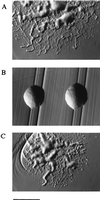Cloning and characterization of the Flavobacterium johnsoniae (Cytophaga johnsonae) gliding motility gene, gldA
- PMID: 9342376
- PMCID: PMC23729
- DOI: 10.1073/pnas.94.22.12139
Cloning and characterization of the Flavobacterium johnsoniae (Cytophaga johnsonae) gliding motility gene, gldA
Abstract
The mechanism of bacterial gliding motility (active movement over surfaces without the aid of flagella) is not known. A large number of nonmotile mutants of the gliding bacterium Flavobacterium johnsoniae (Cytophaga johnsonae) have been previously isolated, and genetic techniques to analyze these mutants have recently been developed. We complemented a nonmotile mutant of F. johnsoniae (UW102-09) with a library of wild-type DNA by using the shuttle cosmid pCP17. The complementing plasmid (pCP100) contained an insert of 13 kbp, and restored motility to 4 of 61 independently isolated nonmotile mutants. A 1.3-kbp fragment that encompassed a single ORF, gldA, complemented all four mutants. Disruption of the chromosomal copy of gldA in wild-type F. johnsoniae UW101 eliminated gliding motility. The predicted protein produced by gldA has strong sequence similarity to ATP binding cassette transport proteins.
Figures




References
-
- Reichenbach H, Ludwig W, Stackebrandt E. Arch Microbiol. 1986;145:391–395.
-
- Burchard R P. Annu Rev Microbiol. 1981;35:497–529. - PubMed
-
- Pate J L. Can J Microbiol. 1988;34:459–465.
-
- Bernardet J-F, Segers P, Vancanneyt M, Berthe F, Kersters K, Vandamme P. Int J Syst Bacteriol. 1996;46:128–148. - PubMed
-
- Pate J L, Chang L-Y E. Curr Microbiol. 1979;2:59–64.
Publication types
MeSH terms
Substances
Associated data
- Actions
LinkOut - more resources
Full Text Sources
Molecular Biology Databases

